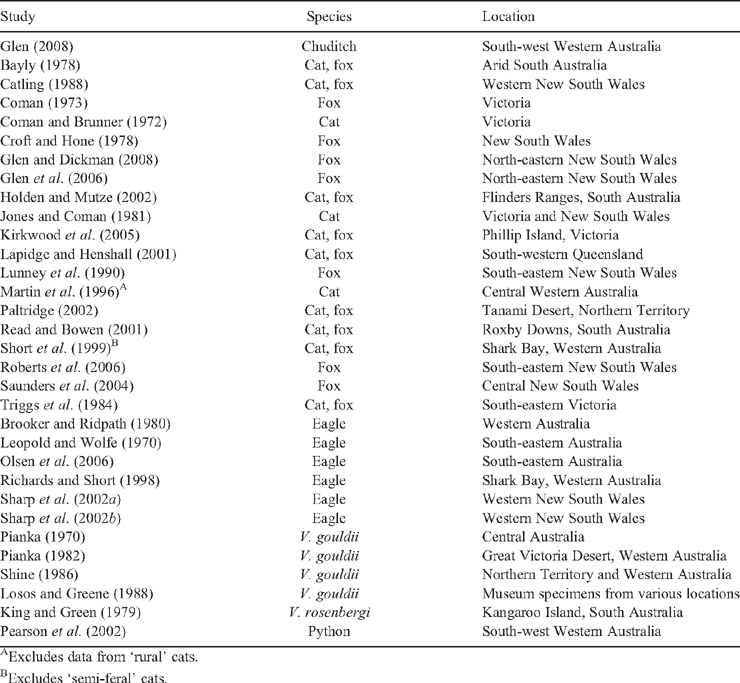Interactions between chuditch (Dasyurus geoffroii) and introduced predators: a review
A. S. Glen A B D , P. J. de Tores A B C , D. R. Sutherland A B and K. D. Morris B CA Department of Environment & Conservation, Dwellingup Research Centre, Banksiadale Rd, Dwellingup, WA 6213, Australia.
B Invasive Animals Cooperative Research Centre, Room D1, Building 3, University of Canberra, Kirinari Street, Bruce, ACT 2617, Australia.
C Department of Environment & Conservation, Woodvale Research Centre, Wildlife Place, Woodvale, WA 6026, Australia.
D Corresponding author. Email: al.glen@dec.wa.gov.au
Australian Journal of Zoology 57(5) 347-356 https://doi.org/10.1071/ZO09041
Submitted: 7 April 2009 Accepted: 17 October 2009 Published: 20 November 2009
Abstract
The chuditch is a carnivorous marsupial that has suffered catastrophic decline since European settlement in Australia. The impacts of introduced foxes and feral cats are thought to have contributed to this decline. Although chuditch populations appear to respond favourably to fox control, ecological theory predicts that other predators, including feral cats, are also likely to increase in abundance when foxes are removed. The flow-on effects of these predicted increases are not known, but are potentially significant for chuditch and for other native fauna. Here, we review the evidence for limiting effects of foxes and feral cats on chuditch populations. We also discuss the likely effects on chuditch populations (direct and indirect) of current fox control practices. Using recent advances in carnivore community ecology, we make testable predictions regarding likely interactions within the predator guild. Experiments should adopt a whole-of-community approach, seeking to clarify the effects of fox control on the entire suite of native and introduced predators, as well as on the abundance and diversity of prey.
Acknowledgements
A. Glen and D. Sutherland are supported by postdoctoral fellowships from the Invasive Animals CRC.
Abbott, I. (2006). Mammalian faunal collapse in Western Australia, 1875–1925: the hypothesised role of epizootic disease and a conceptual model of its origin, introduction, transmission, and spread. Australian Zoologist 33, 530–561.
Catling, P. C. (1988). Similarities and contrasts in the diets of foxes Vulpes vulpes and cats Felis catus relative to fluctuating prey populations and drought. Australian Wildlife Research 15, 307–318.
| Crossref | GoogleScholarGoogle Scholar |
Donadio, E. , and Buskirk, S. W. (2006). Diet, morphology, and interspecific killing in Carnivora. American Naturalist 167, 524–536.
| Crossref | GoogleScholarGoogle Scholar |
Fedriani, J. M. , Fuller, T. K. , Sauvajot, R. M. , and York, E. C. (2000). Competition and intraguild predation among three sympatric carnivores. Oecologia 125, 258–270.
| Crossref | GoogleScholarGoogle Scholar |
Glen, A. S. , and Dickman, C. R. (2005). Complex interactions among mammalian carnivores in Australia, and their implications for wildlife management. Biological Reviews 80, 387–401.
| Crossref | GoogleScholarGoogle Scholar |
Johnson, C. N. , Isaac, J. L. , and Fisher, D. O. (2007). Rarity of a top predator triggers continent-wide collapse of mammal prey: dingoes and marsupials in Australia. Proceedings of the Royal Society of London. Series B. Biological Sciences 274, 341–346.
| Crossref | GoogleScholarGoogle Scholar |
McGee, B. K. , Ballard, W. B. , Nicholson, K. L. , Cypher, B. L. , Lemons, P. R. , and Kamler, J. F. (2006). Effects of artificial escape dens on swift fox populations in northwest Texas. Wildlife Society Bulletin 34, 821–827.
| Crossref | GoogleScholarGoogle Scholar |
Miles, M. A. , de Souza, A. A. , and Póvoa, M. M. (1981). Mammal tracking and nest location in Brazilian forest with an improved spool-and-line device. Journal of Zoology 195, 331–347.
| Crossref | GoogleScholarGoogle Scholar |
Molsher, R. , Newsome, A. , and Dickman, C. (1999). Feeding ecology and population dynamics of the feral cat (Felis catus) in relation to the availability of prey in central-eastern New South Wales. Wildlife Research 26, 593–607.
| Crossref | GoogleScholarGoogle Scholar |
Olsen, J. , Fuentes, E. , and Rose, A. B. (2006). Trophic relationships between neighbouring white-bellied sea-eagles (Haliaeetus leucogaster) and wedge-tailed eagles (Aquila audax) breeding on rivers and dams near Canberra. Emu 106, 193–201.
| Crossref | GoogleScholarGoogle Scholar |
Saunders, G. , Berghout, M. , Kay, B. , Triggs, B. , van de Ven, R. , and Winstanley, R. (2004). The diet of foxes (Vulpes vulpes) in south-eastern Australia and the potential effects of rabbit haemorrhagic disease. Wildlife Research 31, 13–18.
| Crossref | GoogleScholarGoogle Scholar |
Sergio, F. , Marchesi, L. , Pedrini, P. , and Penteriani, V. (2007). Coexistence of a generalist owl with its intraguild predator: distance-sensitive or habitat-mediated avoidance? Animal Behaviour 74, 1607–1616.
| Crossref | GoogleScholarGoogle Scholar |
Sutherland, D. R. , Glen, A. S. , and Cruz, J. (2008). An alternative spool-and-line tracking device for medium-sized animals. Australian Mammalogy 30, 89–90.



